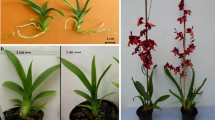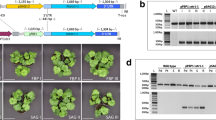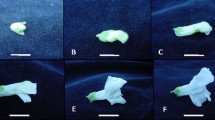Abstract
Transgenic Kalanchoe blossfeldiana Poelln. with reduced ethylene sensitivity in flowers was obtained by Agrobacterium tumefaciens-mediated transformation using the plasmid pBEO210 containing the mutant ethylene receptor gene etr1-1 from Arabidopsis thaliana under the control of the flower-specific fbp1-promoter from Petunia. Three ethylene-resistent T0 lines, 300, 324 and 331, were selected and analyzed for postharvest-performance and morphological characteristics. Line 324 was found to be infertile and only slightly less ethylene-sensitive than control-plants, but lines 300 and 331 had significantly increased ethylene-resistance and were fertile. These two lines were analyzed for copy-number of the etr1-1 gene by Southern blotting and were crossed with the ethylene-sensitive cultivar ‘Celine’ to create T1 progeny. Line 300 contains two T-DNA copies per nucleus, one of which is rearranged, and these are unlinked according to segregation data from the crossing to ‘Celine’ and PCR-analysis of progeny plants. For control plants all flowers were closed after 2 days at 2 μl l−1 ethylene, but for line 300 only 33% were closed after 10 days. Line 331 contains three T-DNA copies per nucleus and is more sensitive to ethylene than line 300. In the line 300 the etr1-1 gene was found by RT-PCR to be expressed in petals and stamens but not in carpels and sepals. Both lines 300 and 331, and their progeny, appear morphologically and physiologically identical to control plants except for the higher ethylene resistance. Line 300 and its progeny with only one T-DNA copy have very low ethylene sensitivity and may be useful in future breeding.








Similar content being viewed by others
Abbreviations
- GA3 :
-
Gibberelic acid
- NAA:
-
α-Naphthaleneacetic acid
- PAMER:
-
Permanently activating mutant ethylene receptor
- RT-PCR:
-
Reverse transcription PCR
- TDZ:
-
Thidiazuron
References
Abeles FB, Morgan PW, Saltveit ME Jr (1992) Ethylene in plant biology, 2nd edn. Academic Press, New York
Aida R, Shibata M (1996) Transformation of Kalanchoë blossfeldiana mediated by Agrobacterium tumefaciens and transgene silencing. Plant Sci 121:175–185
Angenent GC, Franken J, Busscher M, Colombo L, van Tunen AJ (1993) Petal and stamen formation in petunia is regulated by the homeotic gene fbp1. Plant J 4:101–112
Bleecker AB, Estelle MA, Somerville C, Kende H (1988) Insensitivity to ethylene conferred by a dominant mutation in Arabidopis thaliana. Science 241:1086–1089
Bovy AG, Angenent GC, Dons HJM, van Altvorst AC (1999) Heterologous expression of the Arabidopsis etr1-1 allele inhibits the senescence of carnation flowers. Mol Breed 5:301–308
Bowman JL, Smyth DR, Meyerowitz EM (1989) Genes directing flower development in Arabidopsis. Plant Cell 1:37–52
Chen Y-F, Etheridge N, Schaller GE (2005) Ethylene signal transduction. Ann Bot 95:901–915
Ciardi J, Klee H (2001) Regulation of ethylene-mediated responses at the level of the receptor. Ann Bot 88:813–822
Clark DG, Gubrium EK, Barrett JE, Nell TA, Klee HJ (1999) Root formation in ethylene-insensitive plants. Plant Physiol 121:53–59
Cobb D, Schneiter N, Guo S, Humiston GA, Harriman B, Bolar J (2002) Flower specific expression of an ethylene receptor (ETR1-1) confers ethylene insensitivity in transgenic petunia. In: XXVIth international horticultural congress, Toronto, Canada. Book of Abstracts, p 83
Gubrium EK, Clevenger DJ, Clark DG, Barrett JE, Nell TA (2000) Reproduction and horticultural performance of transgenic ethylene-insensitive petunias. J Am Soc Hort Sci 125:277–281
Hoffman T, Schmidt JS, Zheng X, Bent AF (1999) Isolation of ethylene-insensitive soybean mutants that are altered in pathogen susceptibility and gene-for-gene disease resistance. Plant Physiol 119:935–949
Knoester M, van Loon LC, van den Heuvel J, Hennig J, Bol JF, Linthorst HJM (1998) Ethylene-insensitive tobacco lacks nonhost resistance against soil-borne fungi. Proc Natl Acad Sci USA 95:1933–1937
Langston BJ, Bai S, Jones ML (2005) Increases in DNA fragmentation and induction of a senescence-specific nuclease are delayed during corolla senescence in ethylene-insensitive (etr1-1) transgenic petunias. J Exp Bot 56:15–23
Rodriguez FI, Esch JJ, Hall AE, Binder BM, Schaller GE, Bleecker AB (1999) A copper cofactor for the ethylene receptor ETR1 from Arabidopsis. Science 283:996–998
Rogers HJ (2006) Programmed cell death in floral organs: how and why do flowers die? Ann Bot 97:309–315
Sanikhani M, Frello S, Serek M (2006) TDZ induces shoot regeneration in various Kalanchoë blossfeldiana Poelln. cultivars in the absence of auxin. Plant Cell Tiss Org 53:79–84
Serek M, Reid MS (2000) Ethylene and postharvest performance of potted Kalanchoë. Postharvest Biol Technol 18:43–48
Serek M, Sisler EC (2001) Efficacy of inhibitors of ethylene binding in improvement of the postharvest characteristics of potted flowering plants. Postharvest Biol Technol 23:161–166
Serek M, Woltering EJ, Sisler EC, Frello S, Sriskandarajah S (2006) Controlling ethylene responses in flowers at the receptor level. Biotechnol Adv 24:368–381
Sisler EC, Serek M (1997) Inhibitors of ethylene responses in plants at the receptor level: recent developments. Physiol Plant 100:577–582
Sriskandarajah S, Frello S, Jørgensen K, Serek M (2004) Agrobacterium tumefaciens-mediated transformation of Campanula carpatica: factors affecting transformation and regeneration of transgenic shoots. Plant Cell Rep 23:59–63
Sriskandarajah S, Mibus H, Serek M (2007) Transgenic Campanula carpatica plants with reduced ethylene sensitivity showing specific expression of etr1-1 in flowers and buds. Plant Cell Rep 26:805–813
Stepanova AN, Alonso JM (2005) Ethylene signalling and response pathway: a unique signalling cascade with a multitude of inputs and outputs. Physiol Plant 123:195–206
Tzfira T, Li J, Lacroix B, Citovsky V (2004) Agrobacterium T-DNA integration: molecules and models. Trends Genet 20:375–383
Veen H (1983) Silver thiosulfate—an experimental tool in plant science. Plant Cell Rep 22:211–224
Wilkinson JQ, Lanahan MB, Clark DG, Bleecker AB, Chang C, Meyerowitz EM, Klee HJ (1997) A dominant mutant receptor from Arabidopsis confers ethylene insensitivity in heterologous plants. Nat Biotechnol 15:444–447
Woltering EJ (2005) Death proteases come alive. Trends Plant Sci 9:469–472
Zahn LM, Leebens-Mack J, DePamphilis CW, Ma H, Theissen G (2005) To B or not to B a flower: The role of DEFICIENS and GLOBOSA orthologs in the evolution of the angiosperms. J Hered 96:225–240
Acknowledgments
This study was supported by the Iranian Ministry of Science, Research and Technology (Sanikhani), and the Danish Directorate for Food, Fisheries and Agri Business, grant no 3412-06-01545 (Mibus, Serek). The authors would like to thank Professor Gerco Angenent of Plant Research International, The Netherlands, for providing the Agrobacterium strain with plasmid pBEO210, Knud Jepsen A/S, Denmark, for providing plant material and segregation data, and Annette Steding at Leibniz University of Hannover for her excellent technical assistance.
Author information
Authors and Affiliations
Corresponding author
Additional information
Communicated by P. Kumar.
Rights and permissions
About this article
Cite this article
Sanikhani, M., Mibus, H., Stummann, B.M. et al. Kalanchoe blossfeldiana plants expressing the Arabidopsis etr1-1 allele show reduced ethylene sensitivity. Plant Cell Rep 27, 729–737 (2008). https://doi.org/10.1007/s00299-007-0493-6
Received:
Revised:
Accepted:
Published:
Issue Date:
DOI: https://doi.org/10.1007/s00299-007-0493-6




